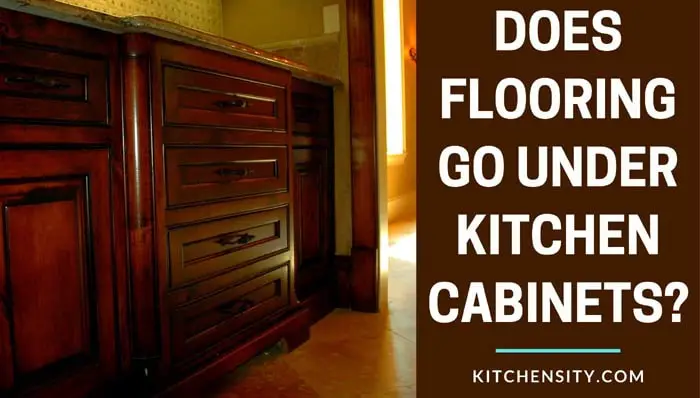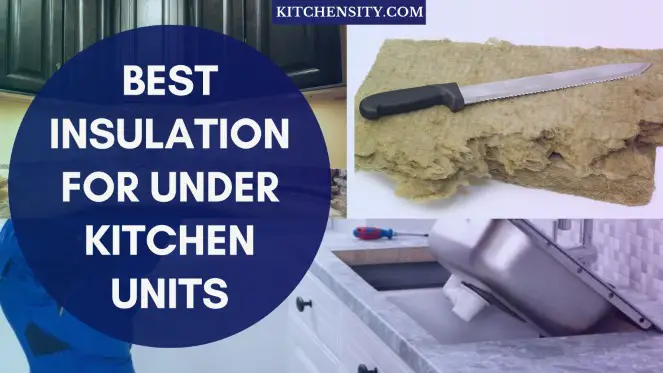Have you ever felt a cold breeze coming from behind your kitchen cupboards? This can be frustrating, especially during the winter months when you are trying to keep your home warm. Not only does a drought make your home feel colder, but it can also increase your energy bills.
To stop a draught from behind kitchen cupboards, first, identify the source, such as gaps around pipes or vents. Seal these gaps with caulk or expanding foam. Use weather stripping around cupboard edges to create a tight seal. Insulate pipes with foam insulation if needed. Check for air leaks around windows and doors, and use draft stoppers at the bottom of cupboard doors.
Consider installing a ventilation system if poor ventilation is the issue. If the draught persists, seek professional inspection for structural problems.

Table of Contents
- 1 What Are Draughts?
- 2 Methods To Stop A Draught From Behind Kitchen Cupboards.
- 3 What Are The Causes Of Draughts Behind Kitchen Cupboards?
- 4 What Are The Benefits Of Stopping Draughts?
- 5 How Can I Heat My Kitchen To Help Prevent Draughts?
- 6 Final Thoughts On Stopping A Draught From Behind Kitchen Cupboards.
- 7 Read More
- 8 FAQs (Frequently Asked Questions)
- 8.1 Can Draughts Cause Health Problems?
- 8.2 Are Draught Excluders Effective?
- 8.3 How Can I Improve The Energy Efficiency Of My Home?
- 8.4 Can A Draught Affect My Energy Bills?
- 8.5 How Does A Toe-Kick Heater Work?
- 8.6 How Do I Know If I Need To Relocate My Cabinets?
- 8.7 How Much Does It Cost To Stop Draughts?
What Are Draughts?
Draughts also spelled drafts, are currents of air that flow through a space, often causing a noticeable movement of air and a feeling of chilliness. Draughts can occur due to gaps or openings in a building’s structure, such as around windows, doors, or pipes, allowing cold air from outside to enter and warm air to escape. They can lead to discomfort and increased energy consumption as heating or cooling systems work harder to maintain a desired temperature.
Also Read – Why Are My Kitchen Cupboards So Cold?
How To Identify The Source Of The Draught?
To stop a draught from behind your kitchen cupboards, you need to identify the source of the draught. Draughts can occur in many different places in a home, including around windows and doors, through ventilation systems, and even behind kitchen cupboards.
The first step in identifying the source of a draught is to inspect the area thoroughly. Begin by removing any items from inside the cupboards and use a flashlight to look for any visible gaps or cracks around the cupboards, walls, or floors. Pay particular attention to areas where pipes or electrical wiring enter or exit the wall.
If you are unable to identify any visible gaps or cracks, try the following methods:
- Use Your Hand: On a windy day, place your hand near the area where you suspect the draught is entering. You should be able to feel a cool breeze if there is a drought.
- Use A Candle: Light a candle and hold it near the suspected area. If the flame flickers or goes out, this may indicate the presence of a draught.
- Use A Smoke Pencil: A smoke pencil is a device that releases a small amount of smoke to help detect air leaks. Hold the smoke pencil near the suspected area and observe the movement of the smoke. If it moves, this may indicate the presence of a draught.
Once you have identified the source of the draught, the next step is to prevent it from entering your kitchen.
Methods To Stop A Draught From Behind Kitchen Cupboards.
- Step 1: Identify the Gaps and Cracks – Inspect the area behind your cupboards for any visible gaps or cracks where air could be entering.
- Step 2: Seal the Gaps and Cracks – Use silicone sealant or caulk to seal the gaps and cracks. Apply the sealant along the edges of the gaps and smooth it out using a putty knife or your finger.
- Step 3: Use Draught Excluders – Install draught excluders along the edges of the cupboards to prevent air from entering. Cut the draught excluders to fit the size of your cupboards.
- Step 4: Install Insulation – If the draught is coming from the walls behind the cupboards, install foam insulation or mineral wool to fill the gaps and prevent air from entering.
- Step 5: Consider Replacing Cupboard Doors – Replace old and worn-out cupboard doors with new ones that fit properly and have a good seal to prevent air from entering.
- Step 6: Cover Unused Vents – Cover unused vents behind your cupboards with insulation or cardboard to prevent air from entering.
- Step 7: Apply Furniture Wax – Apply furniture wax to the edges of your cupboards to fill any gaps and prevent air from entering.
- Step 8: Repair Damaged Skirting Boards – Repair any gaps or cracks in the skirting boards behind your cupboards using wood filler or caulk.
- Step 9: Use a Draught Snake – Place a draught snake along the bottom of your cupboard doors to prevent air from entering.
- Step 10: Add Weatherstripping to Cabinets – Add weatherstripping to the edges of the cabinets to prevent drafts from coming in through the gaps between the doors and the cabinet frames.
- Step 11: Consider Adding a Toe-Kick Heater – Install a toe-kick heater underneath your cabinets to warm the air and prevent cold air from entering.
- Step 12: Add a Door Sweep – Attach a door sweep to the bottom of your cabinet doors to seal the gap between the door and the floor.
- Step 13: Consider Relocating the Cabinets – If all else fails, consider moving the cabinets away from the exterior walls to prevent cold air from entering through gaps and cracks.
- Step 14: Seek Professional Help – If you have tried all the above methods and are still experiencing draughts, seek professional help to identify the source of the draught and find a solution.
You Can Check Out This Video –
What Are The Causes Of Draughts Behind Kitchen Cupboards?
Draughts behind kitchen cupboards can be caused by several factors such as gaps and cracks in the walls, floors, or ceiling, poor insulation in these areas, unused or poorly sealed vents and ducts, inadequately sealed cupboard designs, and external factors like strong winds or cold weather. Identifying and addressing these issues can help reduce or eliminate draughts, improving the comfort and energy efficiency of your kitchen.
The factors are:
- Small gaps or cracks in the walls, floors, or ceiling behind the cupboards can allow air to flow in and out, creating a draught.
- Inadequate insulation in the walls or floors behind the cupboards can allow cold air to seep in and warm air to escape, leading to draughts.
- Unused or poorly sealed vents and ducts behind the cupboards can allow outside air to enter the space, creating a draught.
- The design of the cupboards themselves can contribute to draughts if they are not properly sealed or if there are gaps between the cupboard doors and frames.
- External factors such as strong winds or cold weather can also contribute to draughts behind kitchen cupboards, especially if there are existing gaps or openings in the walls or structure of the house.
According to This Old House “Using a combination of methods, such as draught excluders, insulation, and sealing, can effectively block draughts behind kitchen cupboards, ensuring a more comfortable and energy-efficient home.”
Also Read – How to Insulate Under Kitchen Cabinets?
What Are The Benefits Of Stopping Draughts?
Stopping draughts from behind kitchen cabinets can provide several benefits for your home and your family. Here are some of the main advantages:
- Improved Comfort: By preventing cold air from entering your home and warm air from escaping, you can maintain a more comfortable indoor temperature.
- Energy Savings: Draught-proofing can reduce the amount of energy needed to heat or cool your home, leading to lower energy bills.
- Increased Home Efficiency: Stopping draughts can improve the overall efficiency of your home by reducing heat loss and energy waste. This can make your home more sustainable and eco-friendly.
- Better Indoor Air Quality: Sealing draughts can help prevent dust, pollen, and other outdoor pollutants from entering your home, improving indoor air quality.
- Enhanced Home Value: Stopping draughts can also increase the value of your home by improving its energy efficiency and comfort level. This can be particularly beneficial if you plan to sell your home in the future.
How Can I Heat My Kitchen To Help Prevent Draughts?
To help prevent draughts in your kitchen, you can use various heating methods to maintain a comfortable temperature:
- Use your home’s central heating system to keep the kitchen warm. Ensure that the heating vents are not obstructed by furniture or other objects to allow for proper airflow.
- Use portable space heaters in the kitchen to supplement central heating. Place them in strategic locations to provide additional warmth and prevent draughts.
- Install underfloor heating in the kitchen, which can provide consistent warmth and reduce the likelihood of draughts.
- Install radiators in the kitchen, particularly under windows or in areas prone to draughts, to provide localized heat and counteract cold air infiltration.
- Improve the insulation of your kitchen walls, floors, and ceiling to retain heat and prevent draughts. This can include adding insulation material or upgrading existing insulation.
- Use draught excluders on doors and windows to prevent cold air from entering the kitchen. This can help maintain a warmer temperature and reduce the need for additional heating.
- Use thick curtains or blinds on windows to provide an extra layer of insulation and prevent draughts.
Also Read – How to Insulate Under Kitchen Sink?
What Are The Different Types Of Rugs Or Runners Used To Block Draughts?
Rugs and runners can be a stylish and effective way to block drafts in your home. Here are some different types of rugs and runners that can help block drafts:
- Wool Rugs: Wool rugs are a popular choice for blocking drafts. Wool is a natural insulator and can help to trap warm air in your home. These rugs come in a variety of styles and can be a great addition to your decor.
- Cotton Rugs: Cotton rugs are lightweight and easy to maintain, making them a popular choice for many homeowners. While they may not be as effective at blocking drafts as wool rugs, they can still provide some insulation.
- Felt Rugs: Felt rugs are made from compressed wool fibers and can be an effective way to block drafts. They are typically thicker and heavier than other types of rugs and can be a good choice for areas that experience a lot of cold air.
- Shag Rugs: Shag rugs are a fun and stylish way to block drafts. They are typically made from long, fluffy fibers and can add a cozy and warm feel to your home.
- Runners: Runners are long, narrow rugs that are designed to be placed in high-traffic areas. They can be an effective way to block drafts in hallways, doorways, and other areas where cold air may enter your home.
When choosing a rug or runner to block drafts, it’s important to consider the size and placement of the rug, as well as the materials used. Also, it’s important to ensure that the rug or runner is properly anchored to the floor to prevent it from slipping and causing a safety hazard.
What Are The Different Types Of Weatherstripping Used To Block Draughts?
Weatherstripping is an effective way to block drafts and prevent cold air from entering your home. Here are some different types of weatherstripping that can be used:
- Door Sweeps: Door sweeps are strips of metal, plastic, or rubber that are attached to the bottom of a door to prevent drafts from entering underneath. They can be easily installed with screws or adhesive.
- Foam Tape: Foam tape is a self-adhesive strip made of foam rubber that is used to seal gaps around windows and doors. It can be an inexpensive and effective way to block drafts.
- V-Strips: V-strips are made of vinyl or metal that are used to seal gaps around the sides and top of doors and windows. They are effective at blocking drafts and are easy to install with adhesive or screws.
- Felt Weatherstripping: Felt weatherstripping is made from compressed felt and is commonly used to seal gaps around doors and windows. It can be an effective way to block drafts but may need to be replaced more frequently than other types of weatherstripping.
- Door And Window Gaskets: Door and window gaskets are strips of rubber or silicone that are used to seal gaps around doors and windows. They can be an effective way to block drafts and are easy to install with adhesive.
- Door Shoe: A door shoe is a strip of metal that is attached to the bottom of a door to prevent drafts from entering underneath. They can be easily installed with screws or adhesive.
When choosing weatherstripping, it’s important to consider the size and shape of the gap you are trying to seal, as well as the material the weatherstripping is made of. Also, it’s important to properly clean and prepare the surface before installing weatherstripping to ensure a proper seal.
Also Read – Can You Use Loft Insulation Under Kitchen Cabinets?
What Are The Trees Or Shrubs That Can Be Planted To Help Block Draughts?
Planting trees or shrubs can be an effective way to block drafts and reduce the amount of cold air entering your home. Here are some trees and shrubs that can help block drafts:
- Leyland Cypress: Leyland cypress is a fast-growing evergreen tree that can provide a dense barrier against wind and cold. It is a popular choice for blocking drafts and is easy to maintain.
- Arborvitae: Arborvitae is another evergreen tree that can be used to block drafts. It has a narrow, upright growth habit and can be planted in a row to create a dense barrier.
- Boxwood: Boxwood is a popular shrub that can be used to block drafts. It is easy to maintain and can be pruned to maintain a dense shape.
- Juniper: Juniper is a hardy evergreen shrub that can be used to block drafts. It has a dense growth habit and is easy to maintain.
- American Holly: American Holly is an evergreen tree that can provide a dense barrier against wind and cold. It has a slow growth rate but can live for many years.
Final Thoughts On Stopping A Draught From Behind Kitchen Cupboards.
In conclusion, stopping draughts from behind kitchen cupboards is an essential step in improving the comfort and energy efficiency of your home. By identifying the source of the draught, insulating your cabinets, and sealing gaps and cracks, you can significantly reduce heat loss and energy waste.
Also, using other methods such as weatherstripping, toe-kick heaters, and door sweeps can provide additional protection against draughts. Taking these measures not only saves you money on energy bills but also makes your home more eco-friendly, improves indoor air quality, and increases its overall value.
With the tips and techniques discussed in this article, you can effectively stop draughts from behind your kitchen cupboards and enjoy a more comfortable and efficient home.
Read More
- Best Insulation for Under Kitchen Units
- Best Insulation Under The Kitchen Sink
- What Can I Put Under My Kitchen Sink to Protect My Cabinets?
- Can You Put Kitchen Cabinets On Top Of Vinyl Plank Flooring?
FAQs (Frequently Asked Questions)
-
Can Draughts Cause Health Problems?
Draughts can cause health problems by allowing moisture to enter your home, which can lead to mold and other issues. They can also make your home feel colder, which can exacerbate existing health conditions.
-
Are Draught Excluders Effective?
Draught excluders can be very effective at preventing draughts from entering your home. They are easy to install and can be used in a variety of locations, including doors, windows, and cupboards.
-
How Can I Improve The Energy Efficiency Of My Home?
Improving the energy efficiency of your home can be done by sealing gaps and cracks, installing insulation, upgrading your windows and doors, and using energy-efficient appliances.
-
Can A Draught Affect My Energy Bills?
Yes, draughts can affect your energy bills by allowing cold air to enter your home and warm air to escape. By stopping draughts, you can reduce your energy bills and improve the comfort of your home.
-
How Does A Toe-Kick Heater Work?
A toe-kick heater is a small heating unit that is installed underneath your cabinets. It works by warming the air that is coming in from outside and preventing cold air from entering your home.
-
How Do I Know If I Need To Relocate My Cabinets?
If you’ve tried all the other options and are still experiencing drafts from behind your kitchen cupboards, you may want to consider relocating the cabinets. This is a more drastic option, but it can be effective in preventing drafts.
-
How Much Does It Cost To Stop Draughts?
The cost of stopping draughts behind kitchen cupboards can vary depending on the method used and the severity of the problem. DIY methods like using weatherstripping or foam insulation can cost around $20 to $100, while professional services like cabinet insulation can cost upwards of $500.
Katrina Smith is a seasoned expert with over 25 years of experience in all things related to cooking and the kitchen. As an avid cook and kitchen enthusiast, she is passionate about sharing her knowledge and expertise on cookware, kitchen appliances, kitchen tips, and kitchen staples.
Through her articles and reviews, Katrina aims to inspire and help others improve their cooking skills, experiment with different ingredients, and invest in quality cookware and appliances.

![3 Effective Ways To Update Old Kitchen Cabinets [Under $100] 3 How To Update Old Kitche Cabinets](https://www.kitchensity.com/wp-content/uploads/2021/05/How-To-Update-Old-Kitche-Cabinets.jpg)
![Refacing Kitchen Cabinets: An Ultimate DIY Guide [2023] 4 Refacing Kitchen Cabinets](https://www.kitchensity.com/wp-content/uploads/2021/05/Refacing-Kitchen-Cabinets.jpg)




I’ve been struggling with a draught behind my kitchen cupboards for some time now, and your tips really made a difference. Following your advice to seal the gaps and cracks has significantly reduced the draught and made my kitchen feel much warmer. I appreciate the practical solutions you provided, and I’m grateful for the improvement in my kitchen’s comfort level. Thanks again!
Hi Richard, I’m thrilled to hear that our article helped you tackle the draught behind your kitchen cupboards! It’s great to know that sealing the gaps and cracks made such a noticeable difference.
Thanks for this helpful article! I’ve been dealing with a pesky draught behind my kitchen cupboards for a while now, and your tips really did the trick. I followed your advice to seal any gaps and cracks with silicone sealant, and it made a noticeable difference in keeping the cold air out. My kitchen feels much cozier now, and I no longer have to worry about energy wastage. Thanks again for the practical advice!
Hi Duane, I am thrilled to hear that this article helped you tackle the draught behind your kitchen cupboards! It’s great to know that sealing the gaps with silicone sealant made such a difference. If you have any other home improvement challenges, feel free to reach out.